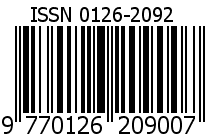Posisi prone pada terapi oksigenasi pasien COVID-19
Abstract
Abstrak
Penyakit Coronavirus 2019 (COVID-19) yang dimulai sejak akhir tahun 2019 cepat menyebar di seluruh dunia hingga dinyatakn sebagai pandemi. Pneumonia menjadi alasan dirawatnya pasien COVID-19 dan memerlukan terapi oksigen. Pneumonia berat menyebabkan terjadinya hipoksemia akibat kegagalan respirasi yang dikenal dengan acute respiratory distress syndrome (ARDS). Posisi prone sudah dikenal sejak lama dapat digunakan sebagai terapi adjuvan untuk meningkatkan ventilasi pasien COVID-19 yang mengalami ARDS.
Kata kunci: COVID-19, Pneumonia, Hipoksemia, ARDS, Posisi prone
Abstract
Coronavirus disease 2019 (COVID-19), which began at the end of 2019 rapidly spread around the world until it was declared as pandemic. Pneumonia is the reason for COVID-19 patients to hospitalized and requires oxygen therapy. Severe pneumonia causes hipoxemia due to respiratory failure which known as acute respiratory distress syndrome (ARDS). The prone position, which has been known for a long time can be used as an adjuvant therapy to improve ventilation for COVID-19 patients who suffrered ARDS.
Keywords: COVID-19, Pneumonia, Hypoxemia, ARDS, Prone position
Full Text:
PDFReferences
WHO. World Health Organization COVID-19 Weekly Epidemiological Update. 2021; (Maret). Diakses dari https://covid19.who.int/?adgroupsurvey={adgroupsurvey}&gclid=Cj0KCQiAv6yCBhCLARIsABqJTjYoBv__VITRJPxEXiutGGnapxPe1IvzGx2cyWrn9kaFFrbqS_FhDoaAgWSEALw_wcB-
Raoof S, Fccp M, Nava S, Carpati C, Hill NS. High-Flow, Noninvasive ventilation and awake ( Nonintubation ) proning in patients with Coronavirus Disease 2019 With Respiratory Failure. Chest. 2020;158(5):1992–2002.
Ghelichkhani P, Esmaeili M. Prone position in management of COVID-19 patients; a commentary. Arch Acad Emerg Med. 2020;8(1):1–3.
Venus K, Munshi L, Fralick M. Prone positioning for patients with hypoxic respiratory failure related to COVID-19. CMAJ. 2020;192(47):1532–7.
Koeckerling D, Barker J, Mudalige NL, Oyefeso O, Pan D, Pareek M, et al. Awake prone positioning in COVID-19. Thorax. 2020;75(10):833–4.
Mathay MA, Zemans RL, Zimmerman GA, et al. Acute respiratory distress syndrome. Nat Rev Dis Primers. 2019;5(1):1-18.
Thompson BT, Chambers RC, Liu KD. Acute respiratory distress syndrome. N Engl J Med. 2017;377:562–72.
Sungnak W, Huang N, Bécavin C, et al. SARSCoV-2 entry factors are highly expressed in nasal epithelial cells together with innate immune genes. Nat Med. 2020;26(5):681-7.
Li W, Moore MJ, Vasilieva N, et al. Angiotensinconverting enzyme 2 is a functional receptor for the SARS coronavirus. Nature. 2003;426(6965):450–4.
Kun Xiao, Fei Hou, Xiuyu Huang, Binbin Li, Zhi Rong Qian, LIxin Xie. Mesechymal stem cells : current clinical progress in ARDS and COVID-19. Stem Cell Res Therapy. 2020; 11(1): 305-12.
Hoffmann M, Kleine-Weber H, Schroeder S, et al. SARS-CoV-2 cell entry depends on ACE2 and TMPRSS2 and is blocked by a clinically proven protease inhibitor. Cell. 2020;181(2):271–80.
Batah SS, Fabro AT. Pulmonary pathology of ARDS in COVID-19: A pathological review for clinicians. Respir Med. 2021;176(106239): 1-7.
Hartini K, Amin Z, Pitoyo CW, Rumende CM. Faktor-faktor yang mempengaruhi mortalitas pasien ARDS di rumah sakit. Indonesian Journal of Chest, Critical and Emergency Medicine. 2014;1(1):21–6.
MAT Acosta, Singer BD. Pathogenesis of COVID-19- induced ARDS: implications for an ageing population. Eur Respir J. 2020;56(3): 1-31.
Levy BD, Choi AM. Acute respiratory distress syndrome. In: Loscalzo J, editor. Harrison‟ pulmonary and critical care medicine. 19th ed. United States of America: The McGraw-Hill Companies. 2015.p.290-6.
Reilly JP CJ. Acute lung injury and the acute respiratory distress syndrome: clinical features, management, and outcomes. In: Grippi MA, Elias JA, Fishman JA, Kotloff RM, Pack AI, Senior RM, editors. In: Fishman’s Pulmonology Diseases and Disorders 5th ed. United States. 2015. p. 4279-90.
Fan E, Beitler JR, Brochard L, Calfee CS, Ferguson ND, Slutsky AS, et al. COVID-19 associated acute respiratory distress syndrome: is a different approach to management warranted? Lancet Respir Med. 2020;8(8):816-21.
Bellan G, Laffey JG, Pham T, Fan E, Brochard L, Esteban A, et al. Epidemiology, patterns of care, and mortality for patients with acute
respiratory distress syndrome in intensive care units in 50 countries. JAMA. 2016;315(8):788- 800.
Burhan E, Susanto AD, Nasution SA, Ginanjar E, Pitoyo CW, Susilo A, et al.Pedoman Tatatalaksana COVID-19 Edisi 5. Jakarta: Perhimpunan Dokter Paru Indonesia (PDPI). 2020.p. 100-2.
Claude Guerin, Richard K. Albert, JeremyBeitler, et al. Prone position in ARDS patients: why, when, how, and for whom. Intensive Care Med. 2020; 46(12): 2385-96.
Pelosi P, Brazzi L, Gattinoni L. Prone position in acute respiratory distress syndrome. Eur Respir J. 2002;20(4):1017–28.
Schifino G, de Grauw AJ, Daniele F, Comellini V, Fasano L, Pisani L. Effects of prone and lateral position in non-intubated patients with 2019 Novel Coronavirus (COVID-19) pneumonia. Pulmonology. 2020;27(2): 167-71.
Vollman, K, Dickinson, S, & Powers, J. Pronation Therapy. AACN Procedure Manual for Critical Care 7th ed. Elsevier Sanders, St Louis, Missouri . 2017.p. 142-63.
WHO. COVID-19 Clinical management: living guidance. January. 2021; 1: 30-4.
Bordes J, Lacroix G, Esnault P, Goutorbe P, Cotte J, Dantzer E, et al. Comparison of the berlin definition with the american european consensus definition for acute respiratory distress syndrome in burn patients. Burns. 2014;40(4):562-7.





















